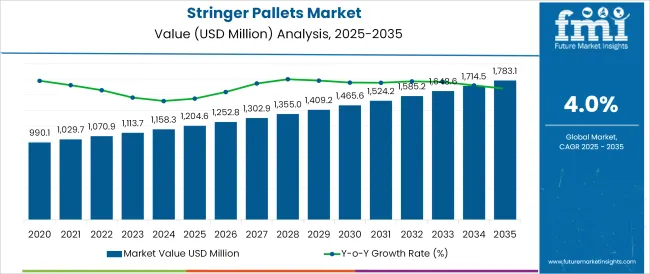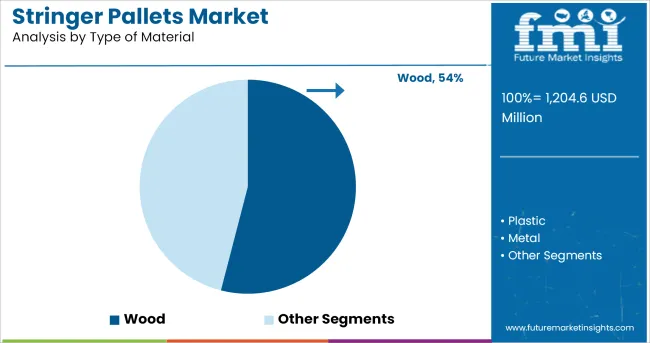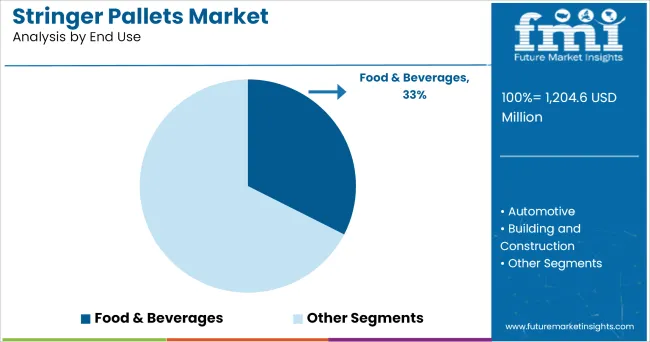The Stringer Pallets Market is estimated to be valued at USD 1,204.6 million in 2025 and is projected to reach USD 1,783.1 million by 2035, registering a compound annual growth rate (CAGR) of 4.0% over the forecast period.

The stringer pallets market is experiencing steady growth, supported by the expansion of global supply chains, increased automation in warehousing, and growing attention to load stability during transport. Stringer pallets, known for their two-way and partial four-way forklift access, continue to serve as a cost-effective and structurally sound choice for material handling across various industries.
Rising trade volumes, especially in food distribution and consumer goods, are propelling pallet demand, with logistics operators seeking durable and easily repairable solutions. Simultaneously, government directives and private sector initiatives focused on circular logistics and material recovery have amplified interest in sustainably sourced pallet materials.
As warehousing infrastructure continues to scale in emerging markets and industries adopt just-in-time inventory strategies, the demand for standardized, high-strength pallets is expected to grow. Going forward, manufacturers focusing on material optimization, reusability, and compliance with hygiene and safety norms will be well-positioned to tap into evolving requirements from food, retail, and industrial sectors.
The market is segmented by Type of Material and End Use and region. By Type of Material, the market is divided into Wood, Plastic, Metal, and Corrugated Paper. In terms of End Use, the market is classified into Food & Beverages, Automotive, Building and Construction, Electronics and Electricals, and Other Industrial.
Regionally, the market is classified into North America, Latin America, Western Europe, Eastern Europe, Balkan & Baltic Countries, Russia & Belarus, Central Asia, East Asia, South Asia & Pacific, and the Middle East & Africa.

The wood material segment is projected to account for 54.0% of the stringer pallets market revenue in 2025, making it the leading material category. This dominance has been supported by wood’s high load-bearing capacity, widespread availability, and ease of repair attributes that make it the preferred choice across logistics-intensive industries.
Its compatibility with automated warehouse handling systems and favorable cost-to-durability ratio have further solidified its position. Additionally, wood pallets are easily customized for varied product sizes and are widely accepted under international phytosanitary standards such as ISPM 15 which supports global trade.
The recyclability and biodegradability of wooden pallets have aligned well with environmental sustainability goals, particularly among companies seeking to lower their carbon footprint. As a result, wood remains the material of choice in high-throughput, cost-sensitive applications, reinforcing its market leadership.

The food and beverages industry is expected to account for 32.5% of the total market revenue in 2025, making it the top end-use segment for stringer pallets. This leadership is driven by the industry's stringent hygiene, safety, and supply chain compliance requirements, which stringer pallets address through structural consistency and material reliability.
The segment’s high pallet turnover rates and need for standardized handling formats have increased reliance on stringer designs due to their dimensional stability and ease of forklift access. Moreover, the growing demand for cold chain logistics, perishable goods transport, and organized retail distribution in the food and beverage space has further accelerated the need for dependable pallet solutions.
Operators prefer stringer pallets for their ability to support both storage and transit in environments ranging from refrigerated units to dry storage. As regulatory scrutiny and quality assurance intensify across food logistics networks, the use of stringer pallets in this segment is expected to sustain its market share leadership.
During the transportation of packaged goods, it is of utmost importance that product is stable and is not damaged in any way due to the shocks and external environmental factors. Pallets are flat structures or platforms that are commonly made of wood and are used to stabilize and minimize the damage caused to the products while in constant movement. The two most common pallets used in the industry are block and stringer pallets.
Stringer pallet type are generally accessible from two sides for lifting operations by forklifts or pallet jacks. The increasing globalization and heightening of import and export activities coupled with elevated packaging needs are bolstering the demand for stringer pallets globally.
One of the major concern for the manufacturing companies is recovering the pallets after delivery of desired products. As most stringer pallets made from wood are reused to fully utilize the lifespan of the pallets it is important to recover them from the destination. It becomes difficult and rather uneconomical if the product is shipped across the continents.
To overcome this issue the recent trend that is gaining popularity in the stringer pallets market is pallet rental system and pallet pooling. This helps the manufacturers to reduce their losses in recovering the pallets and expand their customer base across the globe.
The flourishing logistics industry is a key contributor in driving the demand and sales of the stringer pallets market. As a result of the deliberate efforts of manufacturers and the national governments, the logistics industry has witnessed substantial growth in the past decade.
The increasing use of technology and innovative packaging solutions is supporting the logistics industry growth. Stringer pallets are extensively used in the logistics industry to safeguard freight. The stringer pallets market is anticipated to expand incrementally on the back of the flourishing logistics industry.
Block pallets are gaining popularity in the pallets market as they provide more convenience to the end use industries. The reason behind this is it is designed in such a way that it provides complete four-sided access for the forklifts making the job of loading and unloading much easier. The growing popularity of block pallets in the industry owing to the benefits it offers over the stringer pallets might restrain the growth of the stringer pallets market.

Key global players such as
among others, are in the stringer pallets market. In the Asian region, players like LOSCAM Pty. Ltd., Punj Packaging Industries, S. K. Jindal & Co., Nanjing Xinbiaote Warehousing Equipment Co., Ltd., Weifang Jufeng Metal Products Co., Ltd., Linyi Kunpeng Wood Co., Ltd., Geeta Wood Industries, etc. are actively involved in the stringer pallets market.
Key players in the industry are focused on expanding their geographical reach and product offerings. As a result of many regional players offering stringer pallets in the markets across the globe, the competition is immense.
Global manufacturers in the industry are attempting to form strategic partnerships with regional players and enter into long term agreements with the customers to retain maximum market share and expand their business activities.
The demand for customized stringer pallets according to the packaging requirement of the clients is gaining significant traction. Many manufacturers in the stringer pallets market are shifting towards adopting bespoke manufacturing practices to attract more customers.
The customization is not offered by many players in the stringer pallets market. The elevating demand for customized solutions is creating a huge opportunity for manufacturers to enhance their product offering and capture maximum market share.
China has been and continues to be a hub for manufacturing activities for a large number of products. The ease in accessibility to cheap labor and raw material along with favorable government policies regarding the manufacturing sector are some of the reasons behind attracting global manufacturers to set up their plants in the country.
The constant growth of the country’s manufacturing sector is projected to grow significantly in the foreseeable future. As a result of extensive applications of the stringer pallets in the packaging of many manufactured products the market demand for the stringer pallets is anticipated to bolster on the back of the growing manufacturing industry in China.
The global stringer pallets market is estimated to be valued at USD 1,204.6 million in 2025.
The market size for the stringer pallets market is projected to reach USD 1,783.1 million by 2035.
The stringer pallets market is expected to grow at a 4.0% CAGR between 2025 and 2035.
The key product types in stringer pallets market are wood, plastic, metal and corrugated paper.
In terms of end use, food & beverages segment to command 32.5% share in the stringer pallets market in 2025.






Full Research Suite comprises of:
Market outlook & trends analysis
Interviews & case studies
Strategic recommendations
Vendor profiles & capabilities analysis
5-year forecasts
8 regions and 60+ country-level data splits
Market segment data splits
12 months of continuous data updates
DELIVERED AS:
PDF EXCEL ONLINE
Pallets Market Analysis - Size, Share, and Forecast 2025 to 2035
Global Pallets Market Share Analysis – Trends, Demand & Forecast 2025–2035
Asia Pallets Market Size and Share Forecast Outlook 2025 to 2035
Wood Pallets Market Trends – Innovations & Growth 2025 to 2035
Block Pallets Market Size and Share Forecast Outlook 2025 to 2035
Market Share Breakdown of Block Pallets Industry
Wooden Pallets Market
Plastic Pallets Market Size and Share Forecast Outlook 2025 to 2035
Display Pallets Market Size and Share Forecast Outlook 2025 to 2035
Market Share Distribution Among Display Pallet Manufacturers
Presswood Pallets Market Analysis – Trends & Growth 2025 to 2035
Crates And Pallets Packaging Market
Molded Wood Pallets Market Analysis - Size, Share & Forecast 2025-2035
Competitive Overview of Molded Wood Pallets Market Share
Foldable And Collapsible Pallets Market Size and Share Forecast Outlook 2025 to 2035

Thank you!
You will receive an email from our Business Development Manager. Please be sure to check your SPAM/JUNK folder too.
Chat With
MaRIA